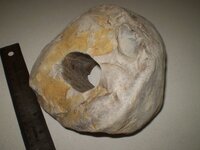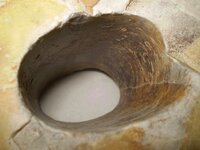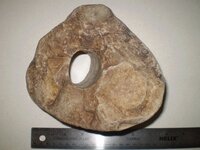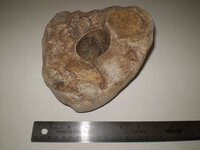electriceye
Jr. Member
- Jun 23, 2012
- 21
- 3
- Detector(s) used
- Minelab ETrac (purchase pending)
- Primary Interest:
- All Treasure Hunting
Hello Folks-
Just happened upon this site and love it already, lots of really neat finds!
After browsing for awhile, I remembered I had a strange rock artifact sitting in my garden. I have never seen this before in a rock and thought maybe someone here might know more about what it is.
Basically this is a decent sized rock, weighing approx 8-10 lbs. It appears to be sedimantary based but not soft, like limestone. It is actually pretty hard!
There is a oval shaped hole almost in the middle of it (approx 1.5"x 2"), that looks and feels fairly smooth..until you look at it with a magnifying glass. There are actually rocks deposits on the walls of this hole, and no signs of modern drilling bits or other manmade boring signs.
Without knowing *what* this thing is, I put together a few different theories:
1. Oval shaped hole in rock was formed by rock growing around a human or animal bone that has since washed away (means it's thousands of years old?)
2. Oval shaped hole was ground out or hollowed out by ancient man to hold a torch in a cave wall. (means it's thousands of years old?)
3. Oval shaped hole was slowly ground out by water over thousands of years. (means it's thousands of years old?)
4. Your guess?
I 'm not really sure what the heck this thing is, but it is intrigiung to say the least. Has anyone else here seen anything like this? One of my friends was over and said it could very well be an ancient man artifact and could be worth a chunk of money...or not.
If you get a chance, take a look at the images (if I can upload them here) and see what YOU think this hunk of rock is. Thanks!




Just happened upon this site and love it already, lots of really neat finds!

After browsing for awhile, I remembered I had a strange rock artifact sitting in my garden. I have never seen this before in a rock and thought maybe someone here might know more about what it is.
Basically this is a decent sized rock, weighing approx 8-10 lbs. It appears to be sedimantary based but not soft, like limestone. It is actually pretty hard!
There is a oval shaped hole almost in the middle of it (approx 1.5"x 2"), that looks and feels fairly smooth..until you look at it with a magnifying glass. There are actually rocks deposits on the walls of this hole, and no signs of modern drilling bits or other manmade boring signs.
Without knowing *what* this thing is, I put together a few different theories:
1. Oval shaped hole in rock was formed by rock growing around a human or animal bone that has since washed away (means it's thousands of years old?)
2. Oval shaped hole was ground out or hollowed out by ancient man to hold a torch in a cave wall. (means it's thousands of years old?)
3. Oval shaped hole was slowly ground out by water over thousands of years. (means it's thousands of years old?)
4. Your guess?
I 'm not really sure what the heck this thing is, but it is intrigiung to say the least. Has anyone else here seen anything like this? One of my friends was over and said it could very well be an ancient man artifact and could be worth a chunk of money...or not.

If you get a chance, take a look at the images (if I can upload them here) and see what YOU think this hunk of rock is. Thanks!




Upvote
2







